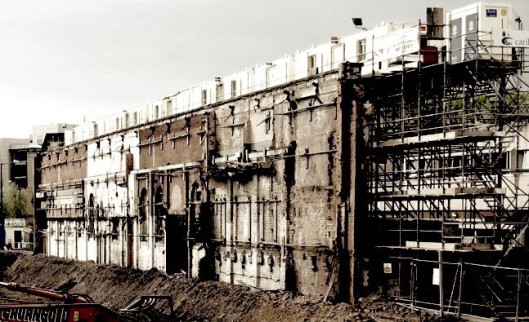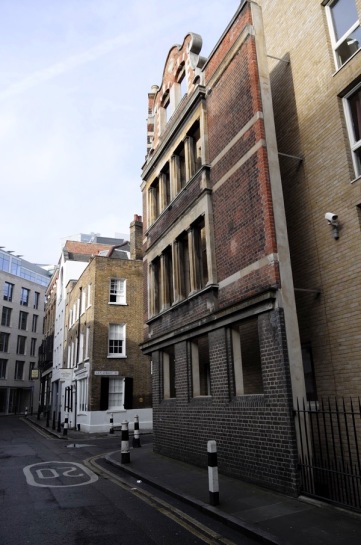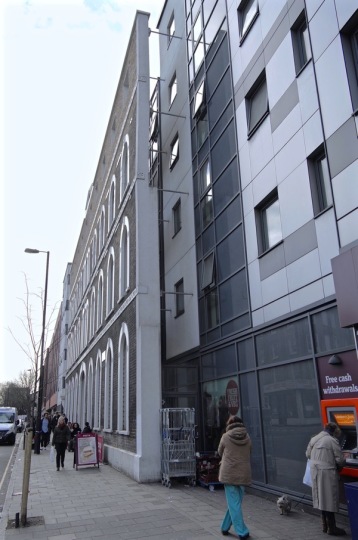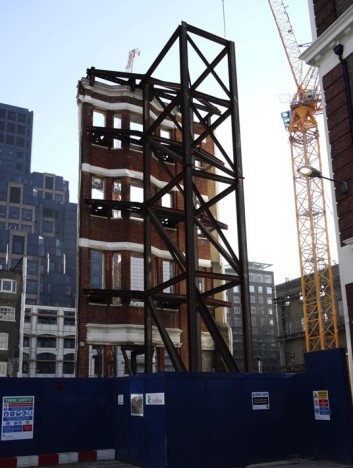
Retained Facade at Temple Back, Bristol. Photo credit: Claire Truman
Facades of older buildings are often seen being gripped onto by society as if their loss would cause a cultural blackhole. The relative success of retaining something which is at risk of becoming a ‘stage set’ will depend on your perspective – objectively and subjectively.
Retained facades often occur when heritage buildings are valued for character they offer to the street but are probably not listed. But what of listed buildings? After all, the whole building is listed – can it be justified to keep essentially a ‘face’ dismembered from its body?
Guest blogger Daniel Snow, a Building Surveyor undergraduate from Liverpool John Moores University, is doing his dissertation on whether retained facades of listed buildings create a balance between priorities of conservation and the pressure of economic growth. Please spare a few moments to add your thoughts on this below.
‘Façade Retention and Listed Buildings
Is Façade Retention the success factor in the development of derelict listed buildings within the North West?
With it being reported there are over 376,000 listed buildings in the UK, the North West alone holds around 27,000 of these. The subject of redevelopment of listed buildings is particularly important in areas like Liverpool who house the largest number of listed buildings than any other city outside of London.

Junction Street, London. Photo credit: Gentle Author, Spitalfields Life 2016.
Reports from Historic England state that there are around 463 entries on their ‘Heritage at Risk Register’ in the North West, it asks the question whether façade retention could provide the answer to the redevelopment of these buildings and contribute to the regeneration of the areas that they lie in, however the choice of façade retention is a route that can’t be picked lightly with many describing it as the most controversial subject to date in architectural conservation. With the number of bad examples out there, there are the same amount of good and it asks how the relationship between the old and new must interact for it to be received well.
Therefore can retained façades provide an economic solution to derelict listed buildings whilst still respecting context?

Caledonian Road, London.Photo credit: Gentle Author, Spitalfields Life 2016
This topic is of particular importance now with it being predicted by 2020 that the average property price in the UK will increase by 22.8%. When looking at areas in the North West like Manchester and Liverpool these cities are being described as having the most dramatic rise in our cities with the properties here being predicted to have a bigger rise in price than values in London. It’s been estimated that prices will rise 21.7% which compared to the 17% rise in London shows how an economic shift could be making its way up North, reflecting in the property prices.

Smithfield, London. Photo credit: Gentle Author, Spitalfields Life 2016
The subject of conservation of listed buildings and economic growth will also be a sensitive area by trying to find the correct balance between the two and with that in mind, my area of study is whether or not façade retention can provide the correct balance between these two?
With demands still present for open plan working and living space does conservation ever have a valid part to play when the economics of that area demand historic buildings being used for modern day purposes?’
Thanks to Daniel for contributing to the blog and raising such an interesting subject for us to ponder. Do offer your thoughts below.
Further Reading

Facadism is a highly emotive topic in the field of building conservation. The purists would argue that it represents ‘skin-deep preservation’, and it is easy to appreciate this view when you see some examples of facadism, such as those in the photographs. However, there are situations in which facadism can be justified. Lancaster (1976) suggests that the preservation of buildings contributes to ‘scenic usefulness’ and obviously it is the facade which makes the greatest contribution. I also like Highfield’s (1991) concept of a facade forming an important component of a townscape. He argues that the walls of a building form the enclosure to both ‘inside rooms’ and ‘outside rooms’ (i.e. the space between buildings). If the inside rooms are not distinguished then perhaps they can be forfeited, but the outside rooms are enjoyed by a much larger audience and so the walls might be retained in the interests of the townscape.
References:
Lancaster, O. (1976) “What should we preserve” in Fawcett, J. (Ed) The Future of the Past; Thames and Hudson
Highfield, D. (1991) The Construction of New Buildings Behind Historic Facades; E&FN Spon
LikeLiked by 1 person
Tony, thanks for your comments – this insight is hugely valuable and certainly has got me thinking more of the wider benefits of facadism. Thank you for including the references which will be interesting to follow up.
LikeLike